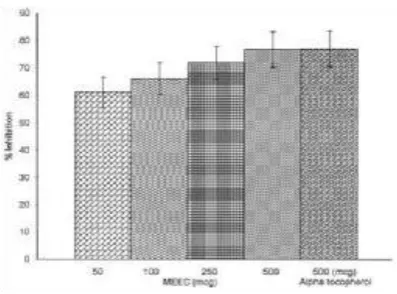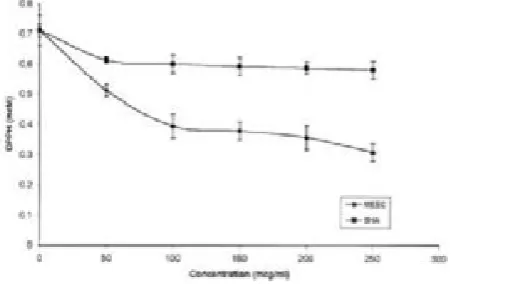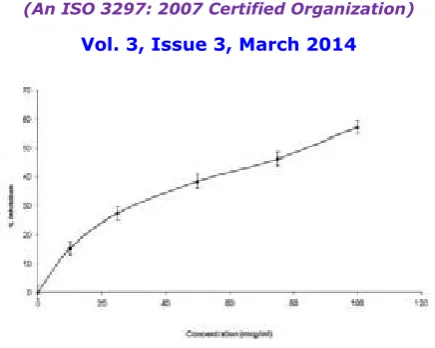ISSN: 2319-8753
I
nternational
J
ournal of
I
nnovative
R
esearch in
S
cience,
E
ngineering and
T
echnology
(An ISO 3297: 2007 Certified Organization)
Vol. 3, Issue 3, March 2014
Antioxidant and Free Radical Scavenging
Activities of
Zingiberofficinale
M. Ismail Shareef
1, S.M. Gopinath
1*, P. Jagan Mohan Reddy
1**, K. S. Dayananda
1, Ajay Mandal
2,
Purushotham K.M***
Department of Biotechnology, Acharya Institute of Technology, Bangalore- 560 107, Karnataka, India1.
Research Scholar, Department of Biotechnology, Acharya Institute of Technology, Bangalore- 560 107, Karnataka, India2.
IAHVB, Hebbal,Bangalore-560024 Karnataka, India***
*Corresponding author, **Mentor
Abstract: The present study was carried out to evaluate the antioxidant and free radical scavenging activity of ethanolic extract of ZingiberofficinaleRhizomes (Zingiberaceae) in various systems. DPPH radical, superoxide anion radical, nitric oxide radical and hydroxyl radicalscavenging assays were carried out to evaluate the antioxidant potential of the extract. The antioxidant activity of ethanolic extract increased in a dose dependent manner. About 50,100, 250 and 500 μg of ethanol extract of Zingiberofficinale(EZO) showed 61.44,66.25, 72.01 and 76.85% inhibition respectively on peroxidation of linoleic acid emulsion. Like antioxidant activity, the effect of EZO on reducing power increases in a dose dependentmanner. In DPPH radical scavenging assay the IC50 value of the extract was found to be 168.09μg/ml. EZO was found to inhibit the nitric oxide radicals generated from sodiumnitroprusside. The IC50 value was found to be 83.365 μg/ml, whereas the IC50 value of curcumin was 20.34 μg/ml. Moreover, the EZO was found to scavenge the superoxide generated byPMS/NADH-NBT system. EZO was also found to inhibit the hydroxyl radical generated byFenton's reaction, where the IC50 value of EZO was found to be more than 1000 μg/ml and for catechin the IC50 value was found to be 5 μg/ml, which indicates the prooxidant activity of EZO. The amounts of total phenolic compounds were also determined in this study. Theresults obtained in the present study indicate that the EZO can be a potential source of naturalantioxidant.
Keywords: Ervatamia coronary; Antioxidant activity; Lipid peroxidation; Free radicalscavenging; DPPH assay
.
I. INTRODUCTION
ISSN: 2319-8753
I
nternational
J
ournal of
I
nnovative
R
esearch in
S
cience,
E
ngineering and
T
echnology
(An ISO 3297: 2007 Certified Organization)
Vol. 3, Issue 3, March 2014
risk of disease(4). Antioxidants are substances that when present in low concentrations, compared to those of an oxidisable substrate significantly delay or prevent oxidation of that substance (5). Apart from their role as health benefactors, antioxidants are also added to food to prevent or delay its oxidation, normally initiated by free radicals formed during the food’s exposure to environmental factors such as air, light and temperature(6). At present most of the antioxidants used for this are manufactured synthetically. The main disadvantage with the synthetic antioxidants is their side effects when taken in vivo (7) . Strict governmental rules regarding the safety of the food has necessitated the search for
Experimental Plant material
The plant Zingiberofficinale was collected in March 2011 from the Bangalore region. The plant material was taxonomicallyidentified by the Botanist, and the Voucher specimen was retained in our laboratory for future reference. The Rhizomes were dried under shade with occasional shifting and then powdered with a mechanical grinder and stored in an airtight container. The dried and powdered Rhizomes (500 g) were defatted with petroleum ether (60-80°C) in a Soxhlet apparatus. The defatted powder material thus obtained was further extracted with ethanol in the Soxhlet for 72 h. The solvent was removedby distillation under suction and the resulting semisolid mass was dried using the rotary flash evaporator to yield (14.51%) a solid residue (ethanolic extract). The dried EZO was suspended in distilled water and used for further studies.
II. MATERIALS AND METHODS
Ammonium thiocyanate was purchased fromE. Merck, Germany. Ferrous chloride, ferricchloride, 1, 1-diphenyl-2-picryl-hydrazyl(DPPH), nicotinamide adenine dinucleotide(NADH), EDTA, butylatedhydroxy toluene(BHT), butylatedhydroxy anisole (BHA), -tocopherol, ascorbic acid, quercetin, catechin,pyrocatechol, curcumin, nitrobluetetrazoliumthiobarbituric acid, 2-deoxy-2-ribose,trichloroacetic acid, phenazinemethosulphate and potassium ferricyanide were all purchased from Sigma Chemical Co. Ltd, USA. All the other unlabeled chemicals and reagents were of analytical grade.
Antioxidant activity
The antioxidant activity of EZO was determined according to the thiocyanate method. About 10 mg of EZO was suspended in10ml water. Various concentrations (50, 100,250 and 500 μg/ml) of EZO were added tolinoleic acid emulsion (2.5 ml, 0.04 M, pH 7.0)and phosphate buffer (2 ml, 0.04 M, pH 7.0).The linoleic acid emulsion was prepared by mixing 0.2804 g of linoleic acid, 0.2804 g of Tween 20 as emulsifier and 50 ml phosphate buffer and then the mixture was homogenized. The final volume was adjusted to 5 ml with potassium phosphate buffer (0.04 M, pH 7.0).Then the mixed samples were incubated at 37 °Cin a glass flask for 60 h to accelerate the oxidation process. Each 12 h, 1 ml of the incubated sample was removed and 0.1 ml ofFeCl2 (0.02 M) and 0.1ml of ammoniumthiocyanate (30%) were added. The amount of peroxide was determined by measuring the absorbance at 500 nm. Alpha tocopherol was used as the reference compound. In order to eliminate the solvent effect, the control sample, which contains the same amount of solvent added into the linoleic acid emulsion in the test sample and reference compound was used. All the data are the average of triplicate analysis. The percentage inhibition of lipid peroxide
generation was measured by comparing the absorbance values of control and those of test samples.
Reducing power
The reducing power of EZO was determined according to the method of Oyaizu(25). 10 mg of EZO extract in 1ml of distilled water was mixed with phosphate buffer (2.5 ml,0.2 M, pH 6.6) and potassium ferricyanide[K3Fe(CN)6] (2.5 ml, 1%). The mixture was incubated at 500C for 20 min. A portion (2.5 ml)of trichloroacetic acid (10%) was added to the mixture, which was then centrifuged at 3000 g for 10 min. The upper layer of the solution (2.5ml) was mixed with distilled water (2.5 ml) andFeCl3 (0.5 ml, 0.1%) and the absorbance was measured at 700 nm. BHT was used as the reference material. All the tests were performed in triplicate and the graph was plotted with the average of three observations.
Inhibition of DPPH radical
ISSN: 2319-8753
I
nternational
J
ournal of
I
nnovative
R
esearch in
S
cience,
E
ngineering and
T
echnology
(An ISO 3297: 2007 Certified Organization)
Vol. 3, Issue 3, March 2014
was plotted with the mean values. The percentage of inhibition was calculated by comparing the absorbance values of the control and test samples.
Inhibition of Nitric oxide radical
Nitric oxide generated from sodiumnitroprusside in aqueous solution a physiological pH interacts with oxygen to produce nitrite ions, which were measured by the Griess reaction. The reaction mixture (3 ml) containing sodium nitroprusside(10 mM) in phosphate buffered saline (PBS) and EZO and the reference compound in different concentrations (10, 25, 50, 75 and 100 μg) were incubated at 25°C for 150 min. Each 30 min, 0.5ml of the incubated sample was removed and 0.5ml of the Griess reagent (1% sulphanilamide, 0.1% naphthylethylenediamine dihydrochloridein 2% H3PO4) was added. The absorbance of the chromophore formed was measured at 546nm. All the tests were performed in triplicate and the results averaged. The percentage inhibition of nitric oxide generated wasmeasured by comparing the absorbance values of control and test samples Curcumin was used as a positive control compound.
Inhibition of Superoxide anion radical
Measurement of superoxide anionscavenging activity of EZO was performed based on the method described by Nishimiki(29) and slightly modified. About 1 ml of nitrobluetetrazolium (NBT) solution containing156 μM NBT which is dissolved in 1.0 ml of phosphate buffer (100 mM, pH 7.4), 1 ml ofNADH solution containing 468 μM of NADH which is dissolved in 1 ml of phosphate buffer(100 mM, pH 7.4) and 0.1 ml of various concentration of EZO and the reference compounds (10, 25, 50, 75 and 100 μg) were mixed and the reaction started by adding 100 μl of phenazinemethosulphate (PMS) solution containing 60 μM of PMS 100 μl of phosphate buffer (100 mM, pH 7.4). The reaction mixture was incubated at 250C for 5 min and theabsorbance at 560 nm was measured against the control samples. BHT and quercetin were used as the reference compounds. All the tests were performed in triplicate and the results are average. The percentage inhibition was calculated by comparing the results of control and test samples.
Inhibition of Hydroxyl radical
Hydroxyl radical scavenging activity was measured by studying the competition between deoxyribose and the test compounds (EZO) for hydroxyl radical generated by Fe3+-Ascorbate-EDTA-H2O2 system (Fenton reaction)according to the method of Kunchandy and Rao(30). The reaction mixture contained in a final volume of 1.0 ml, 100 μl of 2-deoxy-2-ribose (28mM in KH2PO4-KOH buffer, 20 mM, pH 7.4),500mcl of the various concentrations of EZO and the reference compound (1, 100 and 1000μg) in KH2PO4-KOH buffer (20 mM, pH 7.4),200 μl of 1.04 mM EDTA and 200 μM FeCl3(1:1 v/v), 100 μl of 1.0 mM H2O2 and 100 μl of1.0 mM ascorbic acid was incubated at 370C for1h. 1.0 ml of thiobarbituric acid (1%) and 1.0 ml of trichloroacetic acid (2.8%) were added to the test tubes and incubated at 100°C for 20 min. After cooling, absorbance was measured at 532nm against a control sample containing deoxyribose and buffer. Catechin was used as a positive control. Reactions were carried out in triplicate. The percentage inhibition was determined by comparing the results of the test and control compounds.
Amount of total phenolic compounds
Total soluble phenolics present within in theEZO were determined using the Folin-Ciocalteu reagent, according to the method of a Slinkard and Singleton . 0.1 ml of suspension of 1mg of EZO in water was totally transferred into 100 ml Erlenmeyer flask. Then the final volume was adjusted to 46 ml by the addition of distilled water. Afterwards, 1 mlofFolin - Ciocalteu reagent (FCR) was added to this mixture and after 3 min, 3 ml of Na2CO3 (2%) was added. Subsequently, the mixture was shaken on a shaker for 2 hrs at room temperature and then its absorbance measured at 760 nm. All the tests were performed in triplicate and the results averaged. The concentration of total phenolic compounds in EZO was determined as microgram of pyrocatechol equivalent by using an equation that was obtained from the standard pyrocatechol graph. The equation is given below; Absorbance = 0.001 x Pyrocatechol( μg) + 0.0033
Statistical analysis
Experimental results were mean±SD of three parallel measurements. Statistical analysis was performed according to the student t-test and ANOVA procedure. The values for P < 0.05were regarded as significant and the values for P< 0.01 as highly significant.
III. RESULTS AND DISCUSSION
ISSN: 2319-8753
I
nternational
J
ournal of
I
nnovative
R
esearch in
S
cience,
E
ngineering and
T
echnology
(An ISO 3297: 2007 Certified Organization)
Vol. 3, Issue 3, March 2014
normally phenolic orpolyphenolic in nature eg, tocopherols, flavonoids and derivatives of cinnamicacid, phosphatidic and other organic acids.
Antioxidant activity
In this study the antioxidative activity of the leaf extract of Zingiberofficinale was measured using the ammonium thiocyanate method. This method was used to measure the peroxide level during the initial stages of lipidoxidation. The antioxidant activity of EZO might be due to the reduction of hydroperoxideinactivation of free radicals or complexation with metal ions, or combinations thereof. This good antioxidant activity of EZO might beattributed to the presence of phytochemicals such as flavonoids and bi flavones. Figure 1illustrates the antioxidative activities of various concentrations of EZO (50, 100, 250 and 500μg/ml). The different concentrations of EZO(50, 100, 250 and 500 μg/ml) showed antioxidant activities in a dose dependent manner and had 61.33, 66.21, 72.04 and 76.83%inhibition respectively on the lipid peroxidationof linoleic acid system. EZO, at aconcentration of 500 μg/ml showed 76.83%inhibition, which is more or less equal to the antioxidant activity of 500 μg/ml of -tocopherol (77.13%). The IC50 value of EZOon lipid peroxidation was found to be 40.76μg/ml. The results indicate that ethanolic extract of Zingiberofficinale significantly (P<0.05) inhibits the linoleic acid peroxidation.
Figure 1.Inhibition (%) of lipid peroxidation of alphatocopherol and different doses of EZO in the linolic acidemulsion.
Figure 2. Reducing power of EZO and BHT.
ISSN: 2319-8753
I
nternational
J
ournal of
I
nnovative
R
esearch in
S
cience,
E
ngineering and
T
echnology
(An ISO 3297: 2007 Certified Organization)
Vol. 3, Issue 3, March 2014
Inhibition of DPPH radical
The DPPH radical is considered to be a model for a lipophilic radical. A chain reaction in lipophilic radicals was initiated by the lipidautoxidation. The radical scavenging activity of the crude plant extract was determined from the reduction in the optical absorbance at 517 nm due to scavenging of stable DPPH free radical. Positive DPPH test suggests that the samples are free radicals scavengers. The scavenging effects of EZO and BHA on DPPH radical are compared and shown in Figure 3. EZO significant scavenging effects on the DPPH radical and the effects increasing with increasing concentration in the range of 50-250 μg/ml.Compared with that of BHA, the scavenging effect of EZO was lower. The IC50 value of EZO on DPPH radical scavenging assay was found to be 167.09 μg/ml. The results were found to be statistically significant (P<0.05).
Figure 3. Free radical Scavenging activity of EZO and BHA by 1,1-diphenyl-2-picryl hydrazylradicals.Results are mean SD of three parallel
measurements
.
Inhibition of Nitric oxide radical
It is well known that nitric oxide has an important role in various types of inflammatory processes in the animal body. In the present study, the crude extract of the Rhizomes was checked for its inhibitory effect on nitric oxide production. Figure 4 illustrates the percentage inhibition of nitric oxide generation by EZO.Curcumin was used as a reference compound. The concentration of EZO needed for 50%inhibition was found to be 83.38 μg/ml, whereas20.4 μg/ml was needed for curcumin. The results were found to be statistically significant (P<0.05).
Inhibition of Superoxide anion radical
ISSN: 2319-8753
I
nternational
J
ournal of
I
nnovative
R
esearch in
S
cience,
E
ngineering and
T
echnology
(An ISO 3297: 2007 Certified Organization)
Vol. 3, Issue 3, March 2014
Figure4.InhibitionofnitricoxideradicalbyEZOResultsaremeanSDofthreeparallel measurements
.
Figure 5. Superoxide anion scavenging activity of EZOand some doses of quercetin and BHT by PMS/NADH-NBTmethod.
Inhibition of hydroxyl radical
Hydroxyl radicals are the major active oxygen species causing lipid oxidation and enormous biological damage . Ferric-EDTA was incubated with H2O2 and ascorbic acid at pH 7.4. Hydroxyl radicals were formed in free solution and detected by their ability to degrade2-deoxy-2-ribose into fragments that on heating with TBA at low pH form a pink chromogen. When EZO and the reference compound, catechin, added to the reaction mixture they removed hydroxyl radicals from the sugar and prevented degradation. EZO was also capable of reducing DNA damage at all concentrations used. Catechin used as a standard was highly effective in inhibiting the oxidative DNA damage. TheIC50 value of EZO on hydroxyl radical scavenging assay was found to be 1833.73μg/ml. The results were found to be statistically significant (P<0.05).
Amount of total phenolic compounds
ISSN: 2319-8753
I
nternational
J
ournal of
I
nnovative
R
esearch in
S
cience,
E
ngineering and
T
echnology
(An ISO 3297: 2007 Certified Organization)
Vol. 3, Issue 3, March 2014
IV. CONCLUSION
It is well known that free radicals are one of the causes of several diseases, such as Parkinsondisease, Alzheimer type dementia etc. The production of free radicals and the activity of the scavenger enzymes against those radicals, such as superoxide dismutase (SOD) is correlated with the life expectancies .Polyphenols, tannins and flavonoids are very valuable plant constituents in the scavenging action due to their several phenolic hydroxylgroups . The exact constituents of EZO,which shows free radical scavenging action, are unclear. However, the phyto constituents like polyphenol and flavonoids present in the plant extract may be responsible for antioxidant and free radical scavenging activities. Thus, the radical scavenging activity, reductive capability and anti-lipoperoxidant activity strongly suggests that EZO has antioxidant and anti-lipoperoxidant activities. Further studies are needed to evaluate the in vivo antioxidant potential of this extract in various animal models and to isolate the active component.
REFERENCES
[1] SJ.Maxwell, Prospects for the use of antioxidant therapies. Drugs 49: 345:1995.
[2] M, Sato, NRamarathnam, Y.Suzuki, akeuchi M and Ochi H. Varietal differences in the phenolic content and superoxide radical scavenging potential of wines from different sources. J. Agri. Food Chem. 44: 37-41,1996.
[3]D.Stainer, N. Milic,N. Mimica-Dukic, B.Lazic and R.Igic Antioxidant abilities of cultivated and wild species of garlic. Phytother. Res. 12: 513-514, 1998.
[4]C.Sanchez-Moreno, JA.Larrauriand F.Saura-Calixto.Free radical scavenging capacity an inhibition of lipid oxidation of wines, grape juices and related polyphenolic constituents. Food Res. Intern. 32: 407-512:1999.
[5]DJ.Malencic, O. Gasic, M.Popovie and P. Boza. Screening for antioxidant properties of Salvia reflexaHornem. Phytother. Res. 14: 546-548,2000. [6]TA.VanBeek, R.Verpoorte, BaerheimSvendsen, Leeuwenberg and Bisset. (Apocynaceae): a review of its taxonomy, Phytochemistry, ethno botany and pharmacology. J. Ethnopharmacol. 10: 1-56,1984.
[7] KH. PawelkaandJ.StoeckigtIndolealkaloids from cell suspension cultures of Tabernaemontanadivaricata and Tabernaemontanaiboga. Plant Cell Rep. 2 2: 105-107, 1983.
[8]AT.Henriques, AA.Melo, Moreno PRH, Ene LL, Henriques JAP and Schapoval EES. Ervatamiacoronaria: Chemical constituents and some pharmacological activities. J. Ethnopharmacol. 50: 19-25,1996.
[9] Atta-Ur-Rahman, Muzaffar A and Daulatabadi N. Ervatinine, an indole alkaloid from Ervatamiacoronaria. Phytochem. 24: 2473-2474,1985. [10]Yu Y and Liu JK.The constituents of Ervatamiadivaricata. Yunnan ZhiwuYanjiu 21: 260-264 ,1999.


